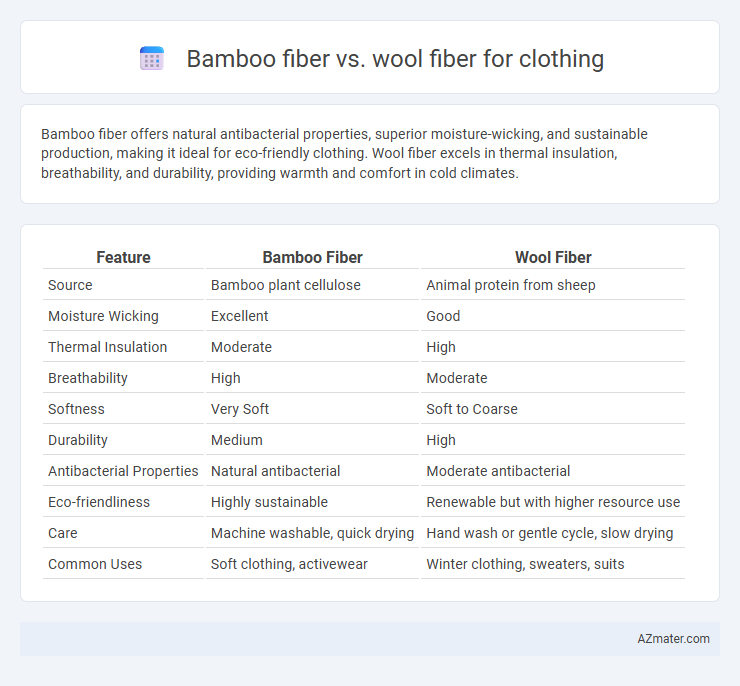Bamboo fiber offers natural antibacterial properties, superior moisture-wicking, and sustainable production, making it ideal for eco-friendly clothing. Wool fiber excels in thermal insulation, breathability, and durability, providing warmth and comfort in cold climates.
Table of Comparison
| Feature | Bamboo Fiber | Wool Fiber |
|---|---|---|
| Source | Bamboo plant cellulose | Animal protein from sheep |
| Moisture Wicking | Excellent | Good |
| Thermal Insulation | Moderate | High |
| Breathability | High | Moderate |
| Softness | Very Soft | Soft to Coarse |
| Durability | Medium | High |
| Antibacterial Properties | Natural antibacterial | Moderate antibacterial |
| Eco-friendliness | Highly sustainable | Renewable but with higher resource use |
| Care | Machine washable, quick drying | Hand wash or gentle cycle, slow drying |
| Common Uses | Soft clothing, activewear | Winter clothing, sweaters, suits |
Introduction to Bamboo and Wool Fibers
Bamboo fiber is derived from the pulp of bamboo grass, known for its softness, breathability, and natural antibacterial properties, making it ideal for sustainable and hypoallergenic clothing. Wool fiber, sourced from sheep, offers excellent insulation, moisture-wicking abilities, and durability, widely used in cold-weather garments and performance wear. Both fibers provide unique benefits; bamboo excels in eco-friendliness and comfort, while wool delivers superior warmth and resilience.
Origin and Sustainability of Bamboo vs Wool
Bamboo fiber is derived from the fast-growing bamboo plant, known for its rapid renewability and minimal need for pesticides or fertilizers, making it a highly sustainable clothing material. Wool fiber comes from the fleece of sheep, a renewable resource that requires land, water, and feed, raising concerns about environmental impact and greenhouse gas emissions in large-scale wool production. Bamboo's regenerative growth and lower carbon footprint position it as an eco-friendly alternative to wool, which is resource-intensive despite being biodegradable and durable.
Fiber Structure and Properties Comparison
Bamboo fiber features a smooth, round cross-section with natural antibacterial properties, moisture-wicking ability, and excellent breathability, making it ideal for sensitive skin and activewear. Wool fiber has a complex, scaly surface with superior insulation, moisture retention, elasticity, and flame resistance, providing warmth even when wet. The fiber structure difference results in bamboo being softer and cooler, while wool excels in durability and thermal regulation for cold climates.
Softness and Comfort: Bamboo vs Wool
Bamboo fiber offers exceptional softness and breathability, making it ideal for sensitive skin and warm climates due to its moisture-wicking and antibacterial properties. Wool fiber provides excellent insulation and durability, with a natural elasticity that retains shape while offering warmth, but it can feel coarse or itchy to some individuals. Choosing between bamboo and wool depends on prioritizing lightweight comfort and softness versus thermal regulation and resilience in clothing.
Breathability and Moisture Management
Bamboo fiber offers superior breathability due to its natural micro-gaps, allowing air to circulate and moisture to evaporate quickly, keeping the wearer cool and dry. Wool fiber, especially merino wool, excels at moisture management by absorbing up to 30% of its weight in moisture without feeling damp, while maintaining thermal regulation. Both fibers provide effective moisture-wicking properties, but bamboo is typically lighter and cooler, making it ideal for warm climates, whereas wool offers better insulation for fluctuating temperatures.
Thermal Regulation and Insulation
Bamboo fiber offers superior thermal regulation due to its natural breathability and moisture-wicking properties, keeping the body cool in hot weather and warm during cooler conditions. Wool fiber provides excellent insulation through its crimped structure, trapping air effectively to retain heat, making it ideal for cold climates. Both fibers harness unique characteristics for temperature control, with bamboo excelling in moisture management and wool in heat retention.
Durability and Longevity in Clothing
Bamboo fiber offers moderate durability with natural antimicrobial properties, but it tends to weaken over time due to frequent washing and exposure to sunlight. Wool fiber, particularly from merino or alpaca, is highly durable and resilient, maintaining its strength and shape even after prolonged use and multiple washes. Wool's natural lanolin content also enhances its longevity by providing water resistance and protection against wear and tear.
Allergenicity and Skin Sensitivity
Bamboo fiber is naturally hypoallergenic and moisture-wicking, making it an excellent choice for sensitive skin and individuals prone to allergies. Wool fiber, especially untreated or coarse types, can cause irritation and itchiness for those with sensitive skin due to lanolin and rough texture. Bamboo's antibacterial properties reduce the risk of skin reactions, while wool requires careful selection of soft, treated varieties to minimize allergenic responses.
Environmental Impact and Biodegradability
Bamboo fiber is renowned for its rapid renewability and low water usage, making it a more sustainable choice compared to wool, which requires extensive land and water resources and methane-emitting livestock. Both fibers are biodegradable, but bamboo decomposes faster due to its plant origin, reducing environmental waste more effectively than wool. Wool's biodegradability is influenced by factors like lanolin content, whereas bamboo's natural cellulose structure promotes quicker breakdown in soil.
Price, Availability, and Market Trends
Bamboo fiber offers a cost-effective and eco-friendly alternative to wool, with prices generally lower due to its quick renewable growth and less intensive processing requirements. Wool fiber, valued for its natural insulation and durability, tends to be pricier and has more seasonal availability influenced by sheep shearing cycles. Market trends show increasing consumer demand for sustainable bamboo textiles, while wool maintains a strong niche in premium and cold-weather apparel sectors.

Infographic: Bamboo fiber vs Wool fiber for Clothing
 azmater.com
azmater.com